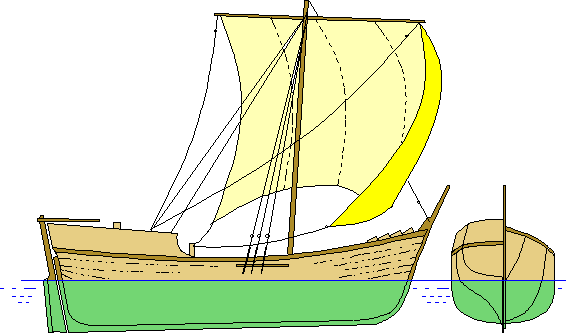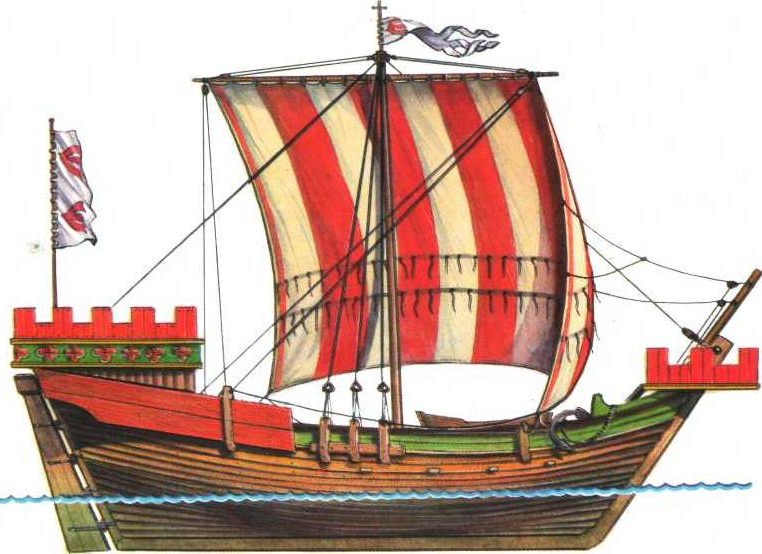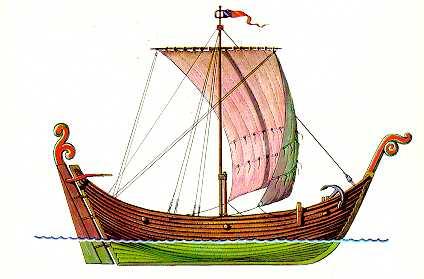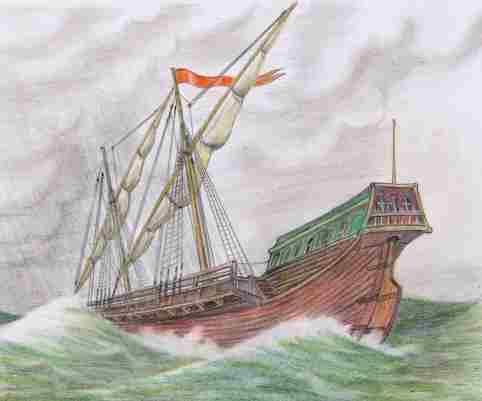
- •Contents
- •Unit I water
- •Text 1a water in human life
- •Text 1b
- •Text 1c
- •Unit II ports
- •Text 2a
- •Text 2b
- •Text 2c
- •Unit III world shipping
- •Text 3a
- •Text 3b
- •Text 3c
- •Unit IV water ecology
- •Vocabulary.
- •Text 4a
- •Text 4b
- •Text 4c
- •Unit V early history of shipbuilding
- •Vocabulary:
- •Text 5a
- •Text 5b
- •Text 5c
- •Unit VI full-riggers
- •Text 6a
- •Text 6b
- •Text 6c
- •Unit VII steam power
- •Text 7b
- •Text 7c
- •Unit VIII great britain as a sea-faring nation
- •Text 8a
- •Text 8b
- •Text 8c
- •Supplemantary texts
- •Abbreviations
- •Geographical and proper names
- •Vocabulary
Text 5b
FISHING VESSEL OF RUSSIAN COAST-DWELLERS
With introduction of sailing arms new daring storm navigating came. It was a storm course on a down wave, which can be used by modern sports yachts. The ancient analogues of such sailing vessels were fishing vessels of Russian north coast-dwellers.
S

The sample of the hull had to provide active maneuvering in the storm sea that was necessary for a leaving in a shelter from real storm danger. Thus the contours of the hull took into account features of storm navigation on a wave, under the control of storm sails and stern rudder.
The vessel had complete aft contours, with deeply put of a rudder blade. Thus the surface part of stern did not hang above water, that was necessary for exception of capture of the hull by a quickly driven crest of a passing wave. The deep rudder blade was at a level of a sole of a wave, as the flow of water in a crest passed much faster than self-vessel going.
The storm sail had to provide moving of the center of sails in a bow that in combination with complete stern and streamline by bow contours made possible reduction of a rate on a wave and on a wind. But bow extremity and keel bottom moved the center of dynamic board resistance to a bow and by that broke stability on a storm course.
Such hull demanded continuous and active management of a movement with the help of a stern rudder. In case the hull nevertheless was grasped and put along of sea waves it was possible to remove a vessel on an initial course only with the help of management of a sail, at once as the vessel lost it.
It’s obvious that sweeping at such mode of navigation was not excluded, but the destructive force of a passing wave was weakened by a course of a vessel forward and consequently water on a deck did not represent serious difficulties on management of a rudder and sail.
Ex. 14. Answer the questions:
-
What storm navigating came with introduction of sailing arms?
-
What such navigation modes were proved by?
-
What peculiarities did the hull design of fishing vessels of Russian north coast-dwellers have?
-
How was possible to remove a vessel on an initial course?
-
What modern vessels can fishing vessels of Russian north coast-dwellers be compared with?
Ex. 15. Read and translate the text:
Text 5c
MEDIEVAL SHIPS
From
the point of view of marine history we by right can call the Middle
Ages t he
Era of Sailing ships. At that period a lot of important geographical
discoveries were made, the development of naval shipbuilding were
moving ahead and overseas trade flourished greatly, especially when
the colonization of new lands started. The sources of world glory of
the sea nations (e. g. Great Britain) took
Pic. 10. The Gokstad Ship
he
Era of Sailing ships. At that period a lot of important geographical
discoveries were made, the development of naval shipbuilding were
moving ahead and overseas trade flourished greatly, especially when
the colonization of new lands started. The sources of world glory of
the sea nations (e. g. Great Britain) took
Pic. 10. The Gokstad Ship
their beginning in that epoch.
The first worth-mentioning seafaring people of that time were the Vikings. Their ships were the best vessels built in northern Europe between the AD 700s and the late 100’s. They built broad, roomy cargo ships called knorrs, but they are best known for their long dragon-like ships. The bold Vikings sailed their dragonships across the North Atlantic Ocean to Greenland and even to North America. They raided, traded and colonized. As pirates they were the terror of the seas.
W


The power of the Vikings gradually declined. By the late 100’s, they had lost control of the northern seas. Trade then began to increase among the countries of northern Europe. Merchants needed roomier vessels to Pic. 12: The Late-Medieval Cog carry larger shipments. By about 1200, shipbuilders in the north had developed a sturdy ship called the cog. It became the standard merchant vessel and warship of northern Europe for about 200 years.
Cogs, later replaced by galleons, could stand up against the rough seas and high winds of the North Atlantic Ocean. Their deep, wide clinker-built hulls held bulky cargoes. These ships had one large square sail. They
also had a high structure called a castle at the prow and the stern. The forecastle served as a platform from which marines could fire arrows and stones at enemy ships. The stern-castle provided a shelter for important passengers. Cogs also had a new kind of steering apparatus. Instead of steering oars along the sides near the stern, cogs had a large rudder in the middle of the stern, much stronger than oars.
W

Galleys had always been used in the Mediterranean region, but about 1300, the use of cargo and merchant galleys increased greatly. They generally used their oars only when there was no wind and when entering or leaving a harbor. The rest of the time the vessels were driven by lateen sails. Most galleys had two or three masts, with the forward mast also carrying sail. The merchant galleys were longer and wider than the war ships. The standard galley could carry about 130 t.
This type of a ship was so successful that continued to be used in the Mediterranean till 1750.
Ex.16. Answer the questions:
1. What historical period is considered the Era of Sailing ships and why? 2. What were the first seafaring people of that time? 3. What ships did the Vikings build and what for were they used? 4. How can we judge about the Viking’s ships? 5. When and why did trade begin to increase between the countries of northern Europe? 6. What were the characteristics and advantages of the cog? 7. What important changes were made in ship building in the Mediterranean? 8. What type of ships was a traditional one for this region? 9. What were the constructive features of medieval galleys? 10. What was the reason, to your mind, for such long-term use of this type of vessel?
Ex. 17. Agree or disagree with the following statements. Give grounds to your answer:
1. The Vikings used their long dragonships both for war and trade. 2. Their ships were suitable for journeys overseas as well as for coastal raiding. 3. We know much about Viking ships because they are still in use in the North. 4. Cogs were the modified versions of knorrs and dragonships. 5. A castle is not only a land fortress but also a part of a ship. 6. A rudder was invented 2000 years ago. 7. Northern and southern Europe used similar types of vessels. 8. There were great differences between ancient and medieval galleys.
Ex. 18. Translate into English:
1. Средние века были эрой расцвета парусного кораблестроения. 2. Первые достойные упоминания парусные корабли того периода были построены викингами. 3. Викинги хоронили своих вождей вместе с их кораблями. 4. К концу I тысячелетия их мощь постепенно ослабла. 5. Хорошо сохранившийся образец такого корабля был обнаружен на раскопках в Норвегии. 6. Эти корабли позволяли перевозить тяжелые громоздкие грузы. 7. Доски корпуса прибивались к каркасу из киля и шпангоутов. 8. Латинский парус имеет треугольную форму. 9. Этот тип паруса не очень подходит для плавания против ветра.
Ex. 19. Abstract the text.
Ex. 20. Summarize the unit information and speak on the topic “Early History of Shipbuilding”
